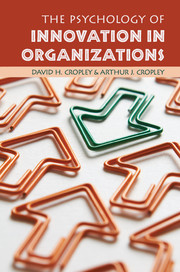Book contents
- Frontmatter
- Epigraph
- Contents
- List of Tables
- List of Figures
- Preface
- Acknowledgments
- 1 Understanding Innovation: A Reorientation
- Part 1 Basic Concepts
- Part 2 managing innovation
- 6 Paradox: The Contradictions of Innovation
- 7 Measuring the Building Blocks of Innovation
- 8 Innovation and Organizational Performance
- 9 Managing the Paradoxes of Innovation
- 10 General Conclusions
- References
- Index
7 - Measuring the Building Blocks of Innovation
from Part 2 - managing innovation
Published online by Cambridge University Press: 05 August 2015
- Frontmatter
- Epigraph
- Contents
- List of Tables
- List of Figures
- Preface
- Acknowledgments
- 1 Understanding Innovation: A Reorientation
- Part 1 Basic Concepts
- Part 2 managing innovation
- 6 Paradox: The Contradictions of Innovation
- 7 Measuring the Building Blocks of Innovation
- 8 Innovation and Organizational Performance
- 9 Managing the Paradoxes of Innovation
- 10 General Conclusions
- References
- Index
Summary
Part 1 of this book presented a framework of four building blocks – person, product, process, and press – that together, as a system, are necessary for innovation. The role that each of these plays in the generation and exploitation of ideas was explained along with some of the challenges that they present to managers seeking to steer their innovation process to a successful outcome. To realize the full value and potential of innovation in organizational settings, however, it is necessary to be able to answer not just subjective, qualitative questions about the people involved, the products developed, the processes used, or the settings in which these are located. Managing and controlling innovation in an organizational context also raises objective, quantitative questions.
It is easy to see why this issue – measurement – is so important to successful innovation. It is one thing for a manager to demand more creative products, but deciding how much more requires a degree of objectivity, rigor, and repeatability. Decision-making processes – one of the convergent aspects of innovation (see Chapter 3) – cannot proceed effectively without an objective basis for selecting product A over product B. Continuous improvement and the ability to learn from mistakes are also harder if organizations cannot reflect on a failed innovation and understand if the product was, for example, too novel or perhaps not effective enough. By the same token, as managers seek to improve their organization's capacity for innovation, they cannot proceed in forming effective teams if they know nothing about the people who make up those teams. If team innovation, for instance, is facilitated by a diverse mix of people who are highly open to experience, excellent convergent thinkers, or willing to take risks, the ability to measure these aspects of the person would be helpful.
The same is true of the processes used to generate novel ideas and the environment in which innovation takes place. The successful management of innovation is built on a foundation of objective measurement of the person, product, process, and press. This chapter addresses the question of measurement for each of the building blocks.
- Type
- Chapter
- Information
- The Psychology of Innovation in Organizations , pp. 143 - 167Publisher: Cambridge University PressPrint publication year: 2015



